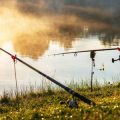Essential Gear for Slab Crappie Fishing
When it comes to targeting slab crappies, having the right gear is half the battle. First, let’s talk rods and reels. A medium-light spinning rod between 6’6” and 8’ offers the perfect blend of sensitivity and backbone for detecting subtle bites and landing those big slabs. Pair it with a quality spinning reel sized in the 1000-2000 range for smooth drag and easy handling. For line, 4-8 lb test monofilament or fluorocarbon is the gold standard—thin enough for stealthy presentations but strong enough to muscle in larger crappies from cover.
Lures That Get Results
When it comes to lures, versatility is key. Tube jigs, curly tail grubs, and small soft plastics in natural colors are tried-and-true favorites for American anglers. Don’t overlook marabou jigs or hair jigs when fish are finicky. For bigger slabs, consider using slightly larger baits like 2-3 inch swimbaits. Tipping your jig with a live minnow can also seal the deal when the bite gets tough.
Must-Have Tackle Box Essentials
No crappie angler should hit the water without a well-stocked tackle box. Bring along an assortment of jig heads (1/32 to 1/8 oz), split shot weights, bobbers, extra hooks, and swivels. Carrying a good pair of needle-nose pliers and a hook remover is also crucial for safe catch-and-release.
Electronics: Modern Tools for Finding Slabs
Today’s serious crappie hunters rely on electronics to find fish faster. A reliable fish finder with side imaging or down imaging helps you locate brush piles, submerged timber, and schools of baitfish where slabs love to hang out. GPS units let you mark productive spots so you can return again and again. Investing in these modern tools can mean the difference between an average day on the water and a true slab fest.
2. Finding Slab Crappies: Prime Locations
Locating slab crappies can feel like searching for a needle in a haystack, but knowing what to look for makes all the difference. Productive lakes, rivers, and reservoirs share certain characteristics that attract big crappies year-round. Understanding how seasonal changes and water structure influence fish behavior is key to consistently finding those trophy slabs.
Tips for Identifying Productive Waters
If you’re scouting new water, start by researching local fishing reports, state wildlife resources, and even social media groups dedicated to crappie fishing in your area. Generally, productive waters have healthy baitfish populations (like shad or minnows), moderate depth variation, and plenty of submerged cover. Lakes with established weedlines, brush piles, or flooded timber almost always hold more and bigger crappies.
Prime Locations Table
| Waterbody Type | Best Spots | Key Features |
|---|---|---|
| Lakes | Coves, drop-offs, standing timber | Submerged brush, weed edges, ledges |
| Rivers | Backwaters, eddies, oxbows | Slower current, woody debris, deep holes |
| Reservoirs | Main-lake points, creek arms | Rocky structure, sunken trees, channel bends |
Seasonal Patterns & Water Structure
Crappie locations change dramatically through the seasons. In spring, look for them shallow during the spawn—think 1-6 feet of water near brush or stumps. As summer heats up, crappies move deeper to chase cooler temps and prey—target submerged structures in 10-20 feet of water. Fall brings them back shallower as they feed up before winter; focus on rocky points and brush piles close to deep water. During winter, concentrate on deep holes and channel bends where crappies stack up tightly.
Quick Tips:
- Use electronics to find schools on drop-offs or suspended over cover.
- If you’re bank fishing, target visible structure like docks or fallen trees.
- Always adjust your depth until you find active fish—it can change daily!
By understanding how to read your local waters and following these tips, you’ll be well on your way to landing more slab crappies no matter where you fish.
![]()
3. Best Times to Target Slab Crappies
If you want to consistently catch big, slab crappies, timing is everything. Understanding their seasonal movements, how they respond to changing weather, and what times of day they’re most active will give you a serious edge on the water.
Seasonal Migrations
Crappies are notorious for moving throughout the year. In early spring, as water temperatures climb into the upper 50s and low 60s, crappies head toward shallow spawning grounds—think brush piles, submerged timber, or weed beds near shorelines. This pre-spawn and spawn period is prime time for targeting slabs in relatively shallow water. After spawning, they retreat to deeper structure: look for them suspended around drop-offs, creek channels, or sunken cover during summer and winter months.
Optimal Weather Conditions
Weather can make or break your day. Stable weather patterns—especially a series of mild, sunny days—tend to get crappies feeding aggressively. Overcast skies can also be fantastic for crappie fishing, as these fish often move shallower and become less wary without bright sunlight overhead. Avoid post-front bluebird days; high pressure usually pushes crappies deeper and makes them sluggish.
The Most Productive Times of Day
Crappies are known for their low-light feeding habits. Early morning (dawn to about 9 a.m.) and late afternoon until dusk are typically the hottest bites. During midday hours, especially in clear water or sunny conditions, crappies often move deeper or hold tighter to cover—so adjust your tactics accordingly if you have to fish during those times.
Local Tips
In many parts of the U.S., the best action happens right before a major cold front or during periods of falling barometric pressure. Keep an eye on local weather apps and plan your trips around those windows for your best shot at a cooler full of slabs.
Bottom Line
To maximize your success targeting slab crappies, plan your outings around seasonal migrations, favorable weather conditions, and peak feeding times at dawn and dusk. With these timing strategies in your arsenal, you’ll be landing more trophy-sized crappies all year long.
4. Effective Presentation and Techniques
When it comes to targeting slab crappies, how you present your bait can make all the difference. Mastering jigging, trolling, and live bait techniques is essential for consistently landing big crappies. Each method has its own strengths, and adapting your approach based on crappie behavior will increase your chances of success.
Jigging: Finesse and Precision
Jigging is a classic technique for crappie anglers. Use light jigs (1/32 to 1/8 ounce) with soft plastics or hair skirts. Vertical jigging near submerged structures or brush piles works best during cooler months when crappies congregate tightly. Experiment with lift-and-drop motions, slow twitches, and pauses to find what triggers bites. Pay close attention to your line—crappies often hit on the fall, resulting in subtle “ticks” or slack in the line.
Trolling: Covering Water Efficiently
Trolling allows you to cover large areas quickly, making it ideal for locating scattered fish in open water or along drop-offs. Use multiple rods set at different depths with small crankbaits, spinners, or Road Runner jigs. Vary your speed between 0.8–1.5 mph to see what draws more strikes. Using planer boards helps spread out lines and reduces tangles, especially when fishing with friends or family.
Live Bait: The Natural Choice
Sometimes nothing beats the real thing. Minnows are the go-to live bait for crappie fishing. Rig them under a slip float or on a plain hook with a split shot for precise depth control. During the spawn, present minnows near shallow spawning beds; in summer and winter, focus deeper around structure. Change minnow sizes or switch to worms when bites slow down—crappies can be finicky eaters.
Technique Comparison Table
| Technique | Best Situation | Main Gear | Key Tip |
|---|---|---|---|
| Jigging | Tight cover & cold water | Light rod, small jig | Watch for subtle line movement |
| Trolling | Open water & covering ground | Multiple rods, crankbaits/jigs | Vary speed and depth regularly |
| Live Bait | Finicky fish & spawn season | Slip float, live minnows/worms | Adjust bait size/depth as needed |
Reading Bites and Adapting to Crappie Behavior
Crappie bites can range from aggressive tugs to barely-there taps. Always keep a finger on your line and be ready for quick hooksets. If you’re getting short strikes, try downsizing your jig or slowing your retrieve. When the bite shuts down after a flurry of action, don’t hesitate to move locations or switch techniques—crappies roam frequently based on water temperature and food availability.
Pro Tip: Stay Versatile!
The most successful crappie anglers are those who constantly adapt their presentation and aren’t afraid to mix things up. Whether you’re vertical jigging in thick brush or long-lining jigs behind the boat, matching your technique to crappie behavior throughout the day is key to filling your limit with slabs.
5. Using Tech: Electronics and Fish Finders
Modern technology has transformed the way anglers target slab crappies. Gone are the days of relying solely on instinct or luck—now, electronics like sonar units, GPS mapping, and fishing apps can give you a serious edge on the water. To get started, invest in a quality fish finder that features high-definition sonar. These devices allow you to scan beneath your boat and locate schools of crappie holding near brush piles, drop-offs, or submerged timber. Pay close attention to how crappies appear on your screen; they’ll often show up as tightly grouped arches or clusters hovering just above structure.
Combining sonar with detailed lake maps is a game-changer. Most modern units offer mapping capabilities that highlight depth contours, creek channels, and other likely crappie hangouts. Use these maps to identify transition zones where crappies move during different times of day or season. Drop pins on productive spots so you can return later or build a milk run of high-percentage locations.
Don’t overlook the power of smartphone fishing apps either. Many provide real-time data like weather forecasts, barometric pressure trends, and even user-generated reports about recent catches. Some apps even sync with your electronics for seamless waypoint sharing between your phone and boat unit. By leveraging these tech tools together, you can eliminate unproductive water, dial in on slab crappie faster, and maximize every trip out—whether you’re tournament fishing or just filling a cooler for a weekend fry.
6. Local Know-How and Etiquette
If you want to consistently catch slab crappies, tapping into local knowledge can give you a serious edge. Start by striking up conversations at bait shops—these spots are hubs for the latest fishing reports, hot lure colors, and even tips about less-crowded honey holes. Many shop owners and regulars are happy to share what’s working, especially if you support their business.
Networking with local anglers is just as important. Whether you’re chatting at the ramp or joining an area fishing group online, swapping stories and strategies helps everyone stay on top of changing conditions. But remember, respect is key: don’t ask for GPS coordinates or secret spots right away. Build trust, share your own insights, and always credit tips when sharing info with others.
It’s also crucial to follow all state and local fishing regulations. Check daily limits, size restrictions, and seasonal closures before you hit the water—this keeps the crappie population healthy for everyone. If you’re unsure about a rule, ask locals or consult the nearest bait shop or wildlife agency website.
Lastly, good etiquette on the water goes a long way in maintaining access and community goodwill. Give fellow anglers plenty of space, avoid crowding popular spots, pick up after yourself, and keep noise to a minimum. Practicing these courtesies ensures that everyone can enjoy targeting slab crappies now and in seasons to come.


